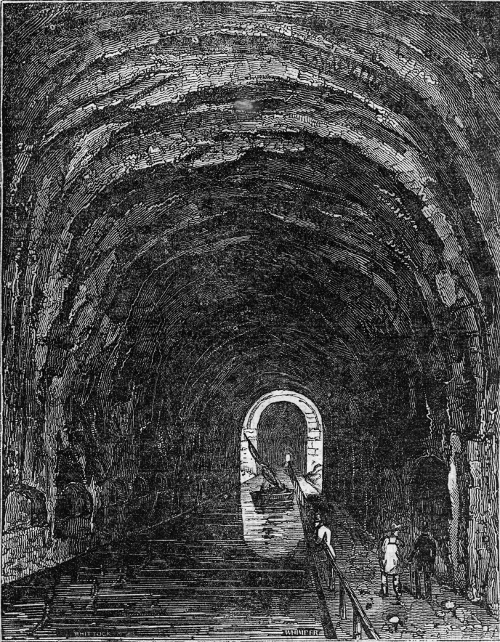|
 |
The Thames and Medway Canal canal was opened in 1824. In 1844 a railway line was placed over the towing path and in 1849 the canal was filled in and became a twin tracked railway tunnel Extract from the Saturday Magazine published 1834 '....The canal, (which is twenty-eight feet wide at the bottom, fifty feet at the top, and has seven feet water,) commences on the southern bank of the Thames, in the parish of Milton; and for more than four miles crosses a dead level, chiefly marsh-land. It then meets with a hill or rib of chalk, which intervenes between this place and the Medway. Through this elevation the tunnel is perforated. Our engraving furnishes a vivid idea of the effect of the subterranean canal. Its entire length exceeds two miles and a quarter, but so true is the line, that the light, at either extremity, is clearly visible when viewed near the opposite end. The width of the excavation is about thirty feet, of which twenty-four feet is appropriated the canal, whilst the remainder of the space is reserved for a towing-path, which is protected by a stout rail of oak, bolted to supports of cast iron, which are let into stone bearers, embedded in the solid chalk. It has not been found necessary to construct an archway of brickwork, except at intervals, during the line; so great is the solidity of the material through which it is carried. The crown of the arched roof rises more than fifteen feet above the level of the towing-path: the sections of the tunnel are of different curvatures, part being parabolic, and part circular, the crown of the arches all coinciding. It is to the reflection of the light from the chalk roof, that we much in a great measure attribute the absence of the almost total darkness, which might be expected to exist in some parts of the tunnel. So far is this from being the case, that about the middle of the excavation, there is sufficient light at noon, to decipher print of a large size. Had the tunnel been arched with brick throughout, however, the absorption of the light would have been so considerable, as to have rendered it necessary to introduce some artificial light; which is evidenced by respectively observing the appearance of the chalk and brick surfaces. The sensations produced on the mind of a stranger, in exploring this vast and dusky passage, are powerful and impressive, and increase with each succeeding step, as the cheerful light of day is left behind: "the reflection of the chalk on the clear surface of the water," says an ingenious writer, "(more distinctly visible as you approach either end,) apparently doubling the magnitude; and the entire absence of every sound but that the the slow and measured footsteps of the quadrupeds employed in towing the craft, stealing the ear at a distance, and becoming louder as it reverberates through the tunnel, combine to produce an emotion of sublimity, which enhances not a little the interest with which the work will be contemplated by the intelligent passenger." In consequence of the canal not being sufficiently wide within the tunnel to permit two barges to pass different ways, they are only allowed to enter wither extremity at stated times; an encounter cannot, therefore, possibly take place, The periods are so arranged, as to allow sufficient time for the passage of one line of barges one way, and that of another line in the opposite direction; and all barges arriving in the interval, are compelled to wait until the regulated period expires, so that is necessary for the barges to be ready at the extremities at the precise time, or they are not permitted to pass until the next turn. About three years since, a small steamer plied on the canal with passengers, between Gravesend and Rochester, passing through the tunnel; the echo made by the noise of her machinery and paddles, was singular and powerful......' |